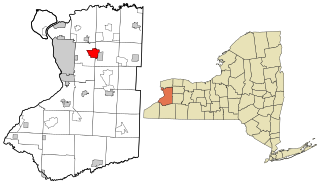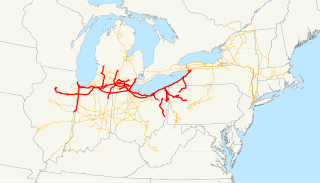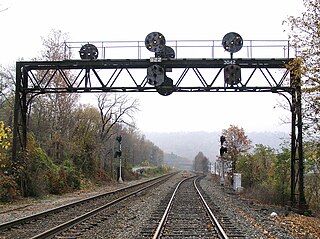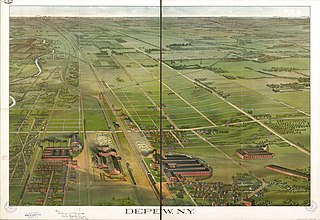
Depew is a village in Erie County, New York. The population was 15,303 at the time of the 2010 census. It is part of the Buffalo–Niagara Falls metropolitan area. The village is named for Chauncey Depew, a politician and one of the original investors who bought the land for the village, which was incorporated in 1894.

West Seneca is a town in Erie County, New York, United States. The population was 44,711 at the 2010 census. West Seneca is a centrally located interior town of the county, and a suburb of Buffalo. West Seneca, Orchard Park and Hamburg form the inner "Southtowns", a cluster of middle-class suburban towns.

The New York Central Railroad was a railroad primarily operating in the Great Lakes and Mid-Atlantic regions of the United States. The railroad primarily connected greater New York and Boston in the east with Chicago and St. Louis in the Midwest, along with the intermediate cities of Albany, Buffalo, Cleveland, Cincinnati, Detroit, and Syracuse. New York Central was headquartered in New York City's New York Central Building, adjacent to its largest station, Grand Central Terminal.

The Delaware, Lackawanna and Western Railroad was a U.S. Class 1 railroad that connected Buffalo, New York, and Hoboken, New Jersey, a distance of 395 miles (636 km). Incorporated in Pennsylvania in 1853 primarily for the purpose of providing a connection between the anthracite coal fields of Pennsylvania's Coal Region and the large markets for coal in New York City. The railroad gradually expanded both East and West, eventually linking Buffalo with New York City.
The Lehigh Valley Railroad was a railroad built in the Northeastern United States to haul anthracite coal from the Coal Region in Pennsylvania. The railroad was authorized on April 21, 1846 for freight and transportation of passengers, goods, wares, merchandise and minerals in Pennsylvania and the railroad was incorporated and established on September 20, 1847 as the Delaware, Lehigh, Schuylkill and Susquehanna Railroad Company. On January 7, 1853, the railroad's name was changed to Lehigh Valley Railroad. It was sometimes known as the Route of the Black Diamond, named after the anthracite it transported. At the time, anthracite was transported by boat down the Lehigh River. The railroad ended operations in 1976 and merged into Conrail along with several northeastern railroads that same year.

The Lake Shore and Michigan Southern Railway, established in 1833 and sometimes referred to as the Lake Shore, was a major part of the New York Central Railroad's Water Level Route from Buffalo, New York, to Chicago, Illinois, primarily along the south shore of Lake Erie and across northern Indiana. The line's trackage remains a major rail transportation corridor used by Amtrak passenger trains and several freight lines; in 1998, its ownership was split at Cleveland between CSX to the east and Norfolk Southern in the west.

For the purposes of this article, the Jersey City area extends North to Edgewater, South to Bayonne and includes Kearny Junction and Harrison but not Newark. Many routes east of Newark are listed here.

The West Shore Railroad was the final name of a railroad that ran from Weehawken, New Jersey, on the west bank of the Hudson River opposite New York City, north to Albany, New York, and then west to Buffalo. It was organized as a competitor to the New York Central and Hudson River Railroad, but was soon taken over by that company.
The Buffalo and Niagara Falls Railroad was a part of the New York Central Railroad system, connecting Buffalo, New York to Niagara Falls. It is still used by CSX for freight and Amtrak for passenger service.

New York State Route 78 (NY 78) is a 73.49-mile-long (118.27 km) state highway in western New York in the United States. While it is signed north–south, the southern portion runs in an east–west direction across Wyoming and Erie counties, from its beginning at a junction with NY 19 north of the village of Gainesville to the village of East Aurora. The part of the route north of East Aurora follows a generally north–south alignment to an intersection with NY 18 in the Niagara County town of Newfane, just south of the Lake Ontario shoreline. The route is most closely identified in the region with Transit Road, a major north–south trunk road through the center of Erie and Niagara counties; however, NY 78 does not follow Transit Road for its entire length, nor does Transit Road comprise more than half its length. The highway joins Transit Road north of East Aurora and stays with the road until nearly its end in the city of Lockport.
Lakeview is a hamlet in Erie County, New York, United States.
The Jersey Shore, Pine Creek and Buffalo Railway was a railroad built in the early 1880s to give the New York Central and Hudson River Railroad access to the coal regions around Clearfield, Pennsylvania, United States. It was originally planned as part of a connecting line between the East Coast of the United States and Buffalo, New York.

The Buffalo Line is a railroad line owned by the Norfolk Southern Railway in the U.S. states of New York and Pennsylvania. The line runs from Buffalo, New York southeast to Rockville, Pennsylvania near Harrisburg, Pennsylvania along a former Pennsylvania Railroad line. Its north end is at Seneca Yard in Buffalo, with no direct access to the Lake Erie district, and its south end is at the Pittsburgh Line at Rockville. The line is operated by the Buffalo and Pittsburgh Railroad between Buffalo and Machias, New York, the Western New York and Pennsylvania Railroad between Machias and Driftwood, Pennsylvania, and the Norfolk Southern Railway between Driftwood and Rockville.

The International Railway Company (IRC) was a transportation company formed in a 1902 merger between several Buffalo-area interurban and street railways. The city railways that merged were the West Side Street Railway, the Crosstown Street Railway and the Buffalo Traction Company. The suburban railroads that merged included the Buffalo & Niagara Electric Street Railway, and its subsidiary the Buffalo, Lockport & Olcott Beach Railway; the Buffalo, Depew & Lancaster Railway; and the Niagara Falls Park & River Railway. Later the IRC acquired the Niagara Gorge Railroad (NGRR) as a subsidiary, which was sold in 1924 to the Niagara Falls Power Company. The NGRR also leased the Lewiston & Youngstown Frontier Railroad.
Gardenville is a hamlet in the town of West Seneca in Erie County, New York, United States.
South Cheektowaga is a neighborhood on the West Seneca border near French Road, in the town of Cheektowaga, in Erie County, New York, United States.

The Lehigh Line is a railroad line in central New Jersey, Northeastern Pennsylvania, and the Lehigh Valley region of eastern Pennsylvania. It is owned and operated by the Norfolk Southern Railway. The line runs west from the vicinity of the Port of New York and New Jersey via Conrail's Lehigh Line to the Susquehanna River valley at the south end of the Wyoming Valley Coal Region. Administratively, it is part of Norfolk Southern's Keystone Division and is part of the Crescent Corridor. As of 2021 the line is freight-only, although there are perennial proposals to restore passenger service over all or part of the line.

Transportation in Buffalo, New York is dominated by automobile use, but other modes of transportation exist in the city.

Depew station was a Lehigh Valley Railroad station in Depew, New York, a suburb of Buffalo. It was the first station east of Niagara Junction, where Lehigh Valley trains left the Buffalo–Jersey City, New Jersey main line for Tonawanda, New York, and thence to Niagara Falls. Passengers heading for Toronto, Ontario would transfer at Depew. The station also handled Canada-bound freight; replacing an interchange operation with the New York Central Railroad at Batavia.













